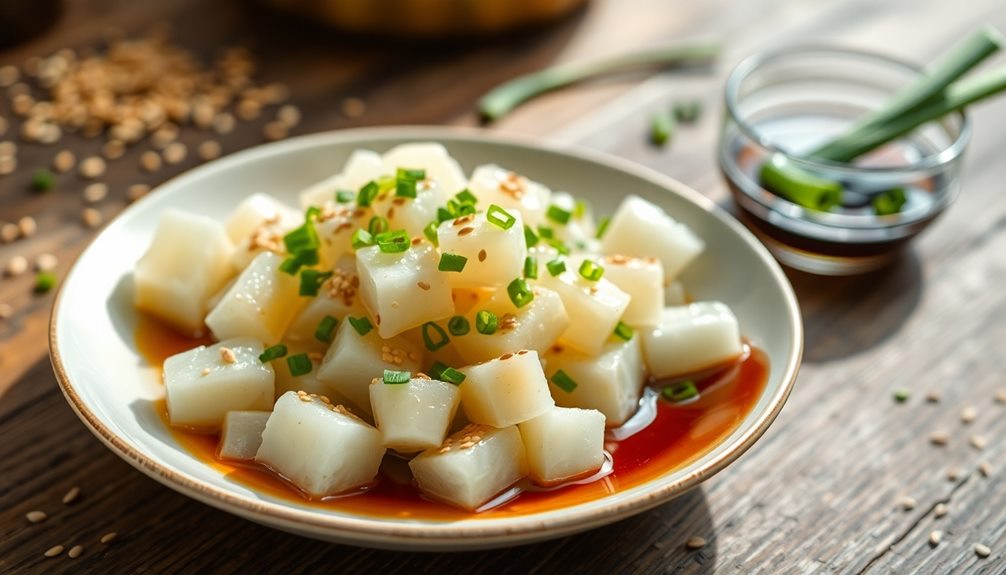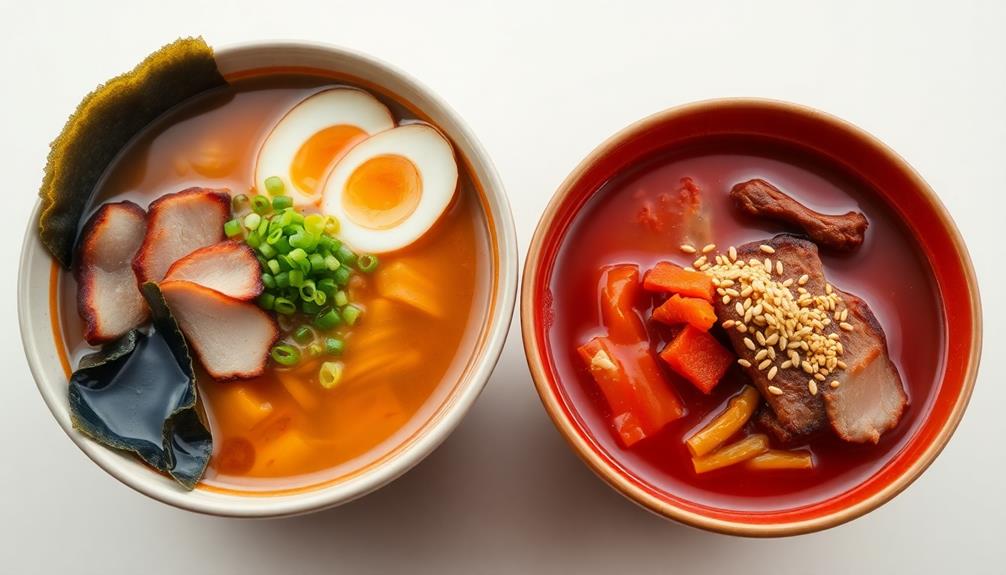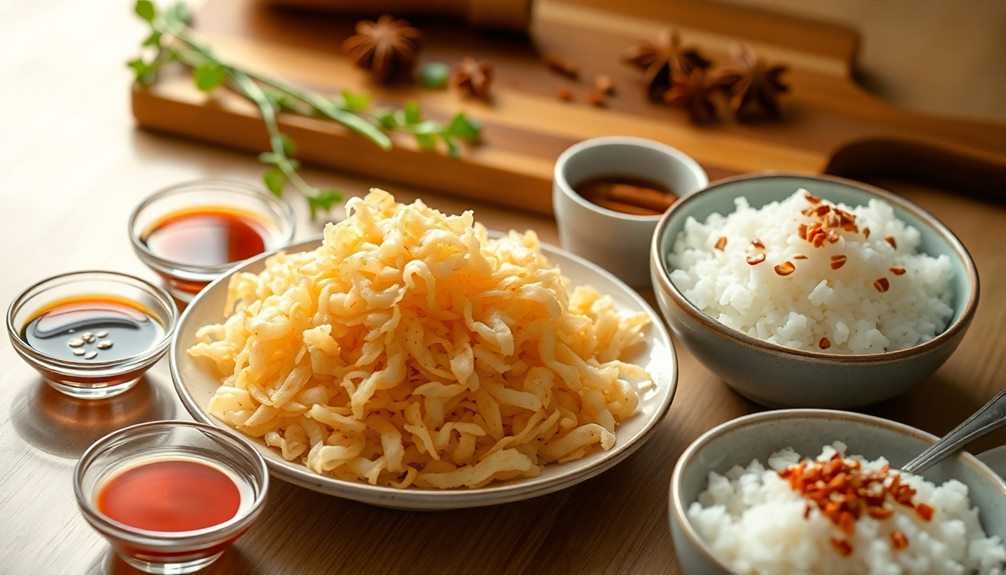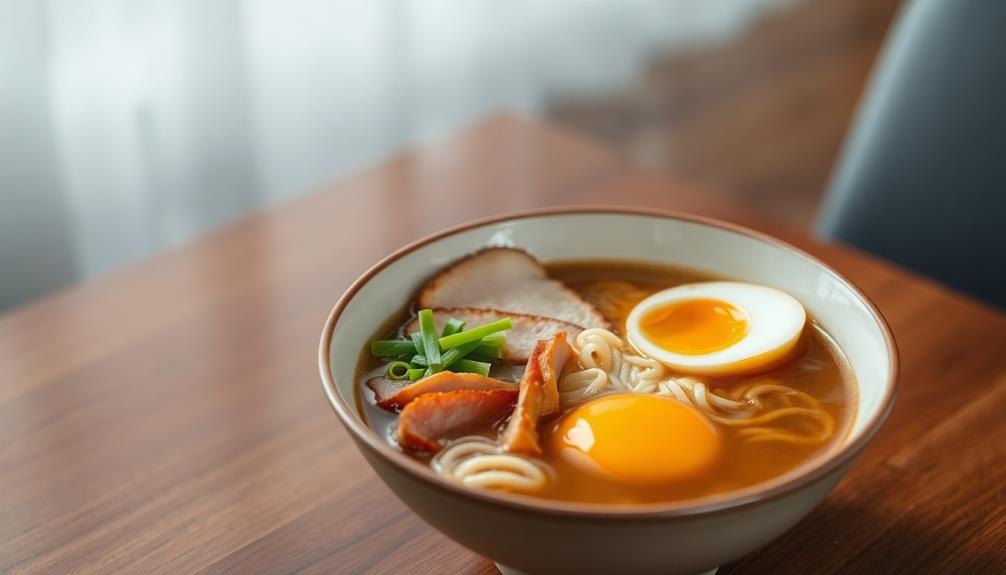Ramen may seem like a Japanese dish, but it actually started as Chinese wheat noodles! They made their way to Japan in the late 1800s, where Japanese cooks added their own special touches. This yummy noodle soup has different styles, like miso in Hokkaido and soy sauce in Tokyo. Ramen grew super popular, especially at street stalls, becoming a comfort food for many. Today, it connects people with its rich flavors and creativity. Aren't you curious about how to make your own delicious bowl of ramen? There's so much more to discover about this tasty dish!
Key Takeaways
- Ramen originated from Chinese wheat noodles introduced to Japan in the late 19th century, highlighting its Chinese roots.
- Japan adapted ramen over time, creating distinct regional variations like miso-based ramen in Hokkaido and soy sauce ramen in Tokyo.
- Ramen became popular in Japan during the early 20th century, symbolizing comfort and accessibility within Japanese culture.
- While ramen has Korean variations, its historical development is primarily rooted in Japanese culinary traditions.
- Today, ramen serves as a cultural bridge, connecting diverse communities through its rich flavors and shared culinary history.
History
The history of ramen is as rich and complex as its flavors, rooted in centuries of culinary evolution. You might be surprised to learn that ramen didn't just pop up overnight! It actually has roots that trace back to China, where wheat noodles were first made. These delicious noodles made their way to Japan in the late 19th century, and that's where the magic began.
As you explore the history, you'll discover that ramen quickly became popular across Japan. Different regions started to create their own unique versions, adding special ingredients and flavors. For example, in Hokkaido, they love miso-based ramen, while in Tokyo, soy sauce is a favorite.
The beauty of ramen lies in its ability to adapt and grow, much like friendships that change over time.
In the early 20th century, ramen stalls began appearing on streets, making this tasty dish accessible to everyone. It became a symbol of comfort and warmth, perfect for sharing with friends and family.
Today, when you slurp up that bowl of ramen, you're enjoying a dish that carries a legacy of creativity and deliciousness, connecting you to people from all walks of life!
Cooking Steps
To create a delicious bowl of ramen, you'll want to follow a few essential cooking steps that bring out the flavors and textures of each ingredient.
First, start with the broth. You can use chicken, pork, or vegetable stock. Heat it up in a pot and let it simmer while you prepare the other ingredients.
Next, cook your noodles. Boil a pot of water, then add the ramen noodles. It usually takes about 3 to 5 minutes to cook them until they're tender but still have a nice bite. Once they're ready, drain them and set them aside.
Now, it's time for the toppings! You can add sliced green onions, soft-boiled eggs, or even some nori (seaweed). Now, it’s time for the toppings! You can add sliced green onions, soft-boiled eggs, or even some nori (seaweed). For an added crunch, sprinkle toasted sesame seeds or crispy garlic chips on top. If you’re feeling inspired, you can draw ideas from a bun mang vit recipe, incorporating tender duck slices or bamboo shoots for a unique twist. These toppings not only enhance the flavors but also make the dish visually stunning!
If you like, you can also include vegetables like bok choy or mushrooms for extra flavor and crunch.
Step 1. Prepare Broth Ingredients

Crafting a rich and flavorful broth is the heart of any great ramen dish. To get started, gather your essential ingredients. You'll need some high-quality meat, like chicken or pork bones, which will give your broth that deep, savory flavor. If you're feeling adventurous, you can even mix different types of bones for an exciting taste!
Next, grab some aromatics. Onions, garlic, and ginger are perfect for adding a delicious kick. Chop them up and set them aside. You might also want to include dried fish or seaweed, like kombu, for an extra umami boost. These ingredients will make your broth taste amazing!
Don't forget about vegetables! Carrots and leeks are great choices. They add sweetness and depth to the broth.
Once you have all your ingredients prepared, it's time to start cooking. Put the bones and aromatics in a large pot, fill it with water, and let it simmer. The longer you let it cook, the better the flavor will be!
Just keep an eye on it, and soon enough, you'll have a beautiful broth ready for your ramen creation. Enjoy the process and smell that delicious broth!
Step 2. Add Seasoning and Spices
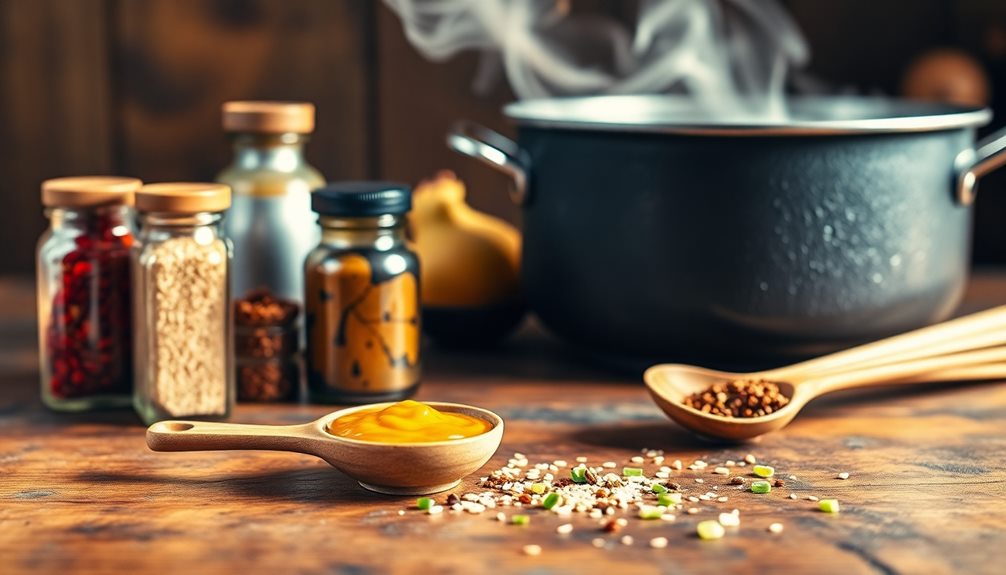
While your broth is simmering away, it's crucial to think about the seasoning and spices that will elevate its flavor. A well-seasoned broth can truly make your ramen special!
Start with soy sauce, which adds a salty, umami kick. Just a splash or two will do! If you're feeling adventurous, try adding miso paste for a deep, savory taste.
Additionally, consider the health benefits of various seasonings, as certain spices can offer potential improvements in blood pressure regulation.
Don't forget about garlic and ginger! These ingredients bring warmth and zest to your broth. You can use fresh or even powdered versions, depending on what you have. A little bit goes a long way!
For some heat, sprinkle in a dash of chili flakes or a few drops of chili oil.
Step 3. Cook Noodles to Perfection

Once the water's boiling, add your ramen noodles. Stir them gently to prevent sticking.
Follow the package instructions for cooking time, usually about 3 to 5 minutes. Keep an eye on them; you want them to be tender but still a bit firm—this is called "al dente." It's like a little dance between cooking and checking!
When they're ready, don't forget to drain the noodles in a colander.
Rinse them quickly under cold water to stop the cooking process. This step helps keep them from getting mushy.
Step 4. Add Toppings and Garnishes
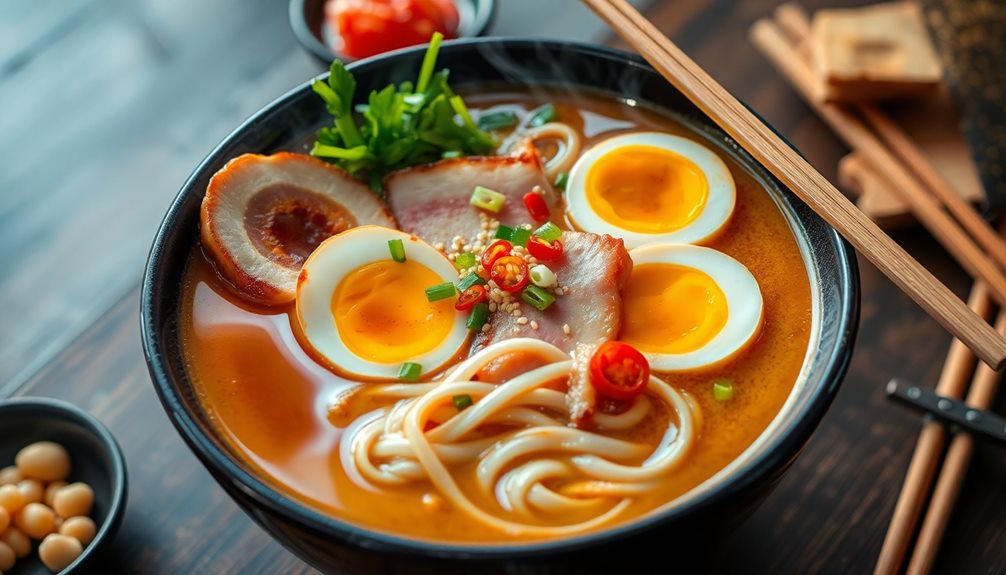
Now that your noodles are ready, it's time to dress them up with delicious toppings and garnishes. This is where your ramen truly comes to life!
You can start by adding slices of tender chashu pork or a soft-boiled egg, which adds a creamy texture. Don't forget the green onions! Chopped scallions sprinkle a fresh crunch that complements your dish perfectly.
Next, consider adding some seaweed sheets, called nori. They add a fun texture and a hint of ocean flavor to your ramen.
If you like a bit of spice, toss in some chili oil or shichimi togarashi for a kick!
And for the veggie lovers, add some bok choy or bean sprouts for extra color and crunch.
Step 5. Serve With a Side Dish
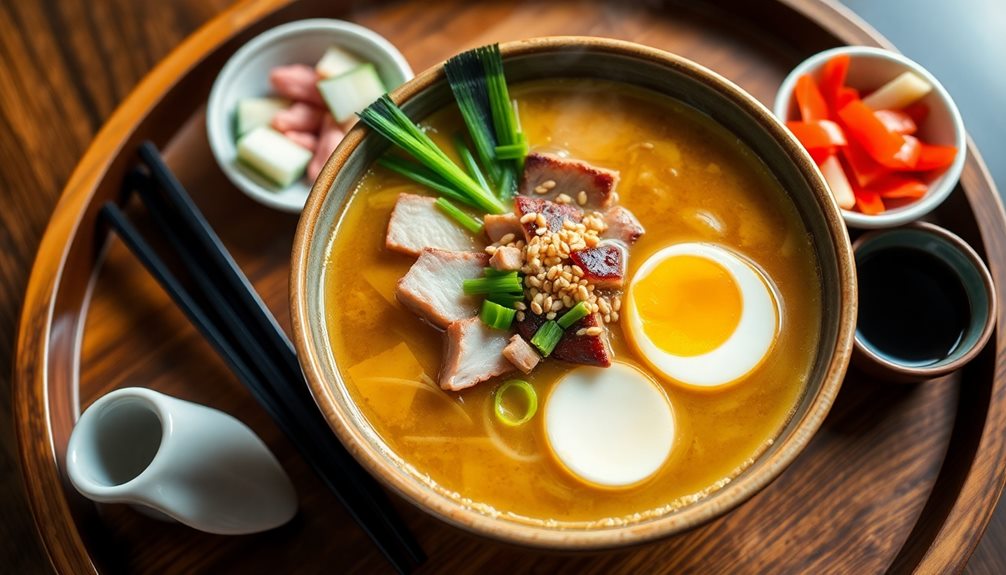
A delicious bowl of ramen deserves a perfect side dish to elevate your meal. When you think of ramen, you might picture a steaming bowl filled with noodles, broth, and toppings, but adding a side dish can take your dining experience to the next level!
One great option is gyoza, those tasty little dumplings filled with meat and veggies. They're crispy on the outside and soft on the inside, making them an awesome complement to your ramen. You can easily pan-fry or steam them for a yummy treat!
Another fantastic choice is edamame. These green soybeans aren't only fun to pop out of their pods, but they're also healthy and delicious. Just sprinkle a little salt on them, and you've got a perfect snack to enjoy alongside your ramen.
If you're feeling adventurous, try making a light cucumber salad. Slice up some cucumbers, toss them with a little vinegar and sesame oil, and you'll have a refreshing side that balances the warmth of your ramen.
Final Thoughts
Ramen's rich history and diverse regional variations offer a fascinating glimpse into culinary evolution. You might wonder if ramen is Korean or Japanese, but the truth is, it's a delightful blend of both cultures. Each bowl you enjoy tells a story, showcasing the creativity and passion of chefs from different countries.
When you slurp your noodles, think about the journey they've made. From ancient China to the bustling streets of Japan and Korea, ramen has transformed over the years. It's not just a meal; it's an experience that connects people through flavors and traditions.
Don't forget to try different toppings and styles! Whether you prefer a rich miso broth or a spicy kimchi twist, there's a ramen out there just waiting for you to discover it. Each bite is a chance to explore new tastes and textures.
Frequently Asked Questions
Which Country Popularized Ramen the Most Outside Asia?
You'll find that the United States has popularized ramen the most outside Asia. With trendy ramen shops and instant noodles flooding grocery stores, it's become a beloved comfort food across the country.
What Are the Main Differences Between Korean and Japanese Ramen?
You'll notice Korean ramen often features a spicy, bold flavor with instant varieties, while Japanese ramen emphasizes umami through rich broth and diverse toppings. Each offers unique textures and tastes that reflect their cultural influences.
Are Instant Ramen Noodles Korean or Japanese in Origin?
Instant ramen noodles originated in Japan in the 1950s. While Korea has its own popular variations, the concept and initial creation of instant ramen are credited to Japanese inventor Momofuku Ando. You'll find both delicious!
How Has Ramen Influenced Global Cuisine Trends?
Ramen's rich flavors and versatility have inspired chefs worldwide. You'll find it reinvented in gourmet dishes, food trucks, and fusion restaurants, blending culinary traditions and sparking interest in Asian cuisine across various cultures.
What Role Does Ramen Play in Cultural Identity?
Ramen's a staple that shapes your cultural identity, reflecting traditions and regional flavors. When you enjoy it, you're connecting with history, community, and even personal memories, making each bowl a unique cultural experience.


